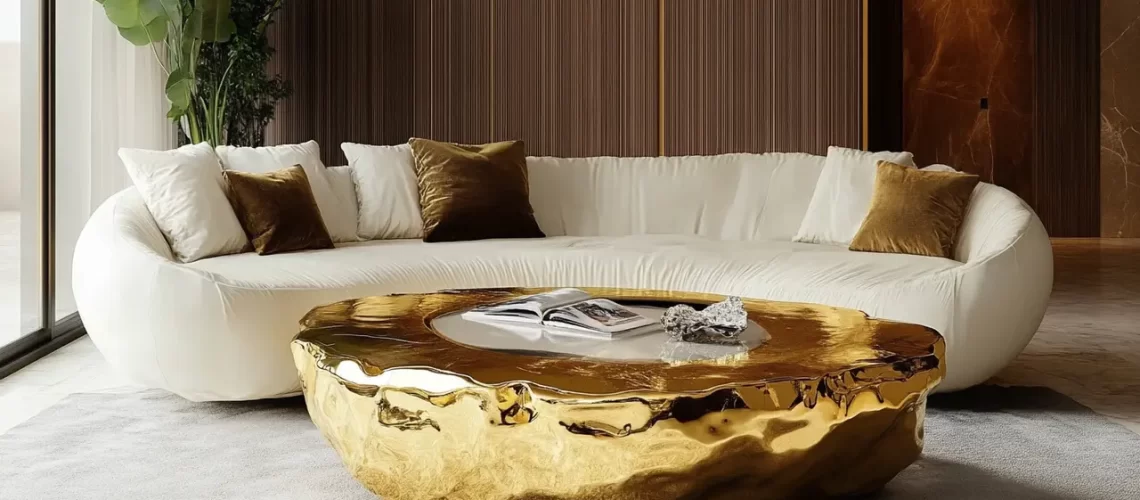Welcome to the world of upscale interior design, where elegance meets functionality. In this blog, we share insider secrets from top designers who have mastered the art of creating luxurious spaces. Whether you’re looking to revamp your living room or transform your entire home, these tips will inspire and guide you on your design journey.
1. Creating a Focal Point
Creating a focal point is the essence of upscale interior design. This strategy involves highlighting certain areas of a room to draw the eye and create an instant impression. The trick is to choose something that stands out, like a grand piece of art, a fireplace, or even a statement piece of furniture. By emphasizing this area, you make it the centerpiece of your design, anchoring the room and giving it a sense of structure and flow.
A focal point does more than just attract attention; it enhances the room’s ambiance by layering on interest and character. To craft a stunning focal point, consider incorporating textures and materials that contrast with the surrounding decor, adding dimension and a touch of elegance. And remember, lighting is key to enhancing this feature, so be sure to illuminate it properly, using both natural and artificial light sources.
2. Mastering the Color Palette
Mastering the color palette is critical in achieving that upscale interior design look. Most high-end designs employ a sophisticated blend of neutral tones with occasional bursts of rich, deep colors to add depth and intrigue. Start by choosing a base of timeless hues such as beige, gray, or taupe, then accentuate with bold shades like emerald green or deep navy.
Color doesn’t just influence the aesthetic of a room; it also affects mood and perception of space. Designers often use color to influence how a room feels—warm tones can create a cozy atmosphere, while cooler colors can expand the perception of space. To effectively master your color palette, consider these high-end tips that blend elegance with functionality.
3. Choosing Quality Over Quantity
In upscale interior design, the mantra is very much ‘less is more.’ Rather than filling a room with many decorative items, the focus should be on a select few of high quality. Elegant, timeless pieces that stand out for their craftsmanship tend to elevate a room’s overall look and feel. By prioritizing quality over quantity, you allow each item to shine, telling its own unique story while contributing to the whole.
Opting for quality doesn’t necessarily mean splurging beyond your budget. It’s about making smart choices that reflect durability and timeless beauty. Whether it’s investing in a beautifully crafted sofa or a piece of art, make sure each selection resonates with your personal style and the overarching theme of your home. Explore the benefits of professional stylists who can guide you in choosing these bespoke items.
4. Lighting as a Design Element
Lighting is an essential aspect of upscale interior design, playing a crucial role in setting the mood and highlighting key design elements. It serves not just a functional purpose but also complements and enhances the aesthetic. Incorporating layered lighting, which includes ambient, task, and accent lights, can dramatically alter a room’s perception.
Each type of lighting has its own role; ambient lighting provides the base, while task lighting focuses on specific areas like a reading nook. Accent lighting is where creativity can flourish, spotlighting art pieces or architectural features to create visual intrigue. Consider smart lighting solutions for customizable control over ambiance, ensuring your design solutions are both elegant and modern.
The choice of fixtures also contributes to an upscale appeal. Opt for designs that are both functional and artistic, such as chandeliers that become statements in their own right. For more impactful and intricate ideas on using lighting as a design element, you can explore visionary lighting solutions.
5. Incorporating Texture and Patterns
Texture and patterns are powerful tools in upscale interior design, adding layers of interest that bring depth and dynamism to a space. The key is to blend various textures like silk, velvet, and wool, each offering a different tactile experience that enriches the room’s atmosphere. Patterns, whether subtle or bold, inject personality into the space.
When incorporating patterns, balance is essential. A heavily patterned wallpaper or rug can serve as an anchor, while smaller patterns in pillows and throws add harmonizing accents. Consider mixing metallics or natural wood textures to contrast softer materials like linens or velvets, crafting a balanced and inviting ambiance. Explore ways smart combinations of these elements can beautifully transform your living space.
6. Balancing Furniture and Space
Balance in furniture arrangement is critical in luxury interiors—every piece should enhance, not crowd, the overall design. Careful planning ensures a harmonious flow where each piece works together rather than competing for attention. This creates an inviting environment, blending aesthetics with functionality.
Consider the scale and proportions of your furniture relative to the size of the room. Choosing pieces that fit the space will prevent it from feeling cramped or sparse. This is where quality furnishings come into play; even fewer, thoughtfully placed items can exude opulence when they complement the space’s dimensions effectively. Benefits of professional styling might come in handy for achieving this balance.
7. Using Art to Elevate the Interior
Art is a transformative element that can elevate the ambiance of any space, infusing it with a unique personality and style. Choosing the right pieces is about more than just aesthetics; it’s about resonance. Select art that speaks to you and complements the design of the space, acting as a focal point or a subtle accent.
When placing art, consider its relationship with other elements in the room. Proper spacing and alignment can enhance the perceived size and sophistication of a piece. Lighting can further enhance artwork, spotlighting its textures and details. A well-curated collection of art pieces adds a gallery-like allure to upscale spaces, perfectly dovetailing with the interior’s overall design narrative.
8. Enhancing with Decorative Accents
Decorative accents are the finishing touches that bring a room to life, adding those personal signatures that make a space uniquely yours. From sculptural vases to antique trinkets, these elements imbue rooms with personality and charm. In upscale interior design, accents should be chosen with an eye for quality and proportion.
A well-placed decorative item can become a conversation starter, while too many can clutter the space. The goal is to enhance the aesthetic without overwhelming the design. Incorporating metallics, rich woods, or glass not only adds contrast but also luxuriousness, providing balance across textures and finishes. Also, regularly updating these accents can keep your space feeling fresh and contemporary.
9. Open Spaces and Flow
In high-end design, open spaces and a seamless flow between rooms are pivotal for creating an airy, luxurious atmosphere. Consider an open floor plan that removes unnecessary barriers, allowing for free movement and visual continuity. This not only maximizes space but also the light, giving rooms a spacious and inviting feel.
Strategic use of furniture and decor can define areas without breaking the flow. Rugs and lighting can demarcate spaces for different purposes while maintaining a cohesive look. The open-plan design encourages social interaction, making the home not just aesthetically pleasing but also functional and warm.
10. Integrating Smart Home Technology
Innovation lies at the heart of luxe modern living, and integrating smart home technology is at the forefront of high-end interior design. These advanced systems can control lighting, climate, security, and entertainment seamlessly, offering convenience alongside a sleek aesthetic that remains unobtrusive. This isn’t just about technology for technology’s sake; it’s about creating a living experience tailored to comfort and efficiency.
Current smart home trends focus on having systems that blend into the design. From automated window treatments to invisible sound systems, these technologies ensure your home remains elegant and functional. Delving into visionary design services might provide further inspiration on seamlessly integrating these modern conveniences.
11. Embracing Sustainable Design
Sustainability is becoming an essential aspect of upscale interior design. Integrating eco-friendly practices is not just a trend but a necessity for those who seek to align luxury with environmental consciousness. Sustainable living solutions including the use of recycled materials, energy-efficient appliances, and non-toxic finishes create homes that are as responsible as they are beautiful.
Opting for sustainably sourced materials, from reclaimed wood to natural fibers, adds character and story to your home while reducing your environmental footprint. Beyond aesthetics, these choices support a holistic approach to wellness, not only for the occupants but for the broader ecosystem. For more on merging luxury with sustainability, explore integrated sustainable solutions for a healthier home environment.
12. Personalizing Your Space
While high-end design may exhibit certain common traits, the personal touch is what truly individualizes a space, making it resonate with those who inhabit it. Personalization goes beyond mere preference; it’s about curating a space that reflects your experiences, tastes, and aspirations. Whether through family heirlooms or custom-built furniture, letting your personality shine is the heart of any upscale home.
Personalized art installations, book collections, or even statement walls featuring custom finishes can tell your story and transform a space with sentimental value. Professional design services can help distill your essence into your space, ensuring both style and personal touch intertwine seamlessly. Consider the ways artistic personalization reflects and honors your individuality.


